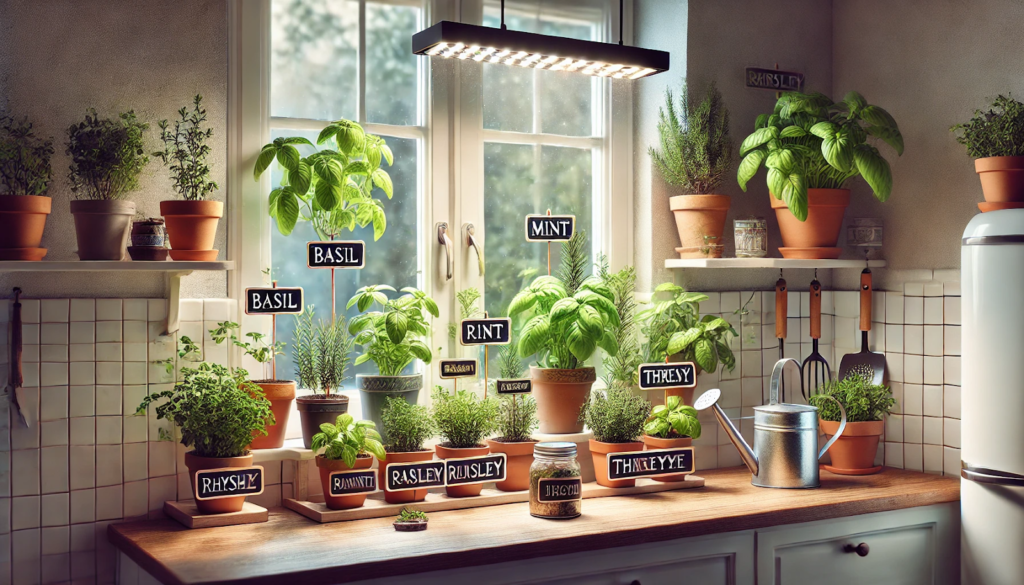Growing herbs indoors is one of the easiest and most rewarding ways to enjoy fresh, flavorful additions to your meals all year long. Whether you’re in a cold winter climate or a small apartment with no outdoor space, you can still maintain a thriving herb garden right in your kitchen or living room.
This guide will show you how to grow herbs indoors successfully, from choosing the right plants to providing proper care.
Why Grow Herbs Indoors?
- Freshness: Use herbs at their peak flavor whenever you cook.
- Convenience: Accessible any time of day without needing to go outside.
- Cost Savings: No need to buy packaged herbs that spoil quickly.
- Aesthetics: Greenery adds charm and life to your indoor space.
Best Herbs to Grow Indoors
Choose herbs that are compact, adaptable to indoor conditions, and have high culinary value. These are the easiest to grow indoors:
- Basil
- Mint
- Parsley
- Thyme
- Chives
- Rosemary
- Oregano
- Cilantro
- Sage
Choosing the Right Containers
Herbs don’t need deep pots but do require good drainage.
Tips:
- Use pots with drainage holes to prevent root rot.
- Avoid overly large containers, which can lead to soggy soil.
- Terracotta pots are great for airflow but dry out faster.
Selecting the Best Location
Light is crucial for herbs. Most need at least 6 hours of sunlight per day to thrive.
Ideal Spots:
- South or west-facing windowsills
- Under kitchen skylights
- Near sliding glass doors
If natural light is limited, consider using grow lights to supplement.
Using Grow Lights
Grow lights are ideal for winter months or low-light homes.
Types of Grow Lights:
- LED Grow Lights: Energy-efficient and long-lasting
- Fluorescent Tubes: Good for shelves or multiple plants
- Clamp Lamps with Full-Spectrum Bulbs: Flexible and easy to aim
Set lights 6–12 inches above the plants and keep them on for 12–16 hours daily.
Soil and Fertilizer
Herbs grow best in well-draining, nutrient-rich soil.
Recommendations:
- Use a high-quality potting mix, not garden soil.
- Avoid over-fertilizing; use organic or balanced liquid fertilizer monthly.
- Add perlite or sand to improve drainage if needed.
Watering Indoor Herbs
Herbs prefer moist, but not soggy, soil. Overwatering is the most common mistake.
How to Water:
- Water when the top inch of soil feels dry.
- Use room temperature water.
- Ensure excess water drains from the pot.
- Mist occasionally to raise humidity, especially in winter.
Harvesting Your Herbs
Regular harvesting encourages more growth and bushier plants.
Best Practices:
- Use clean scissors to cut just above a set of leaves.
- Never remove more than one-third of the plant at once.
- Harvest in the morning for the best flavor and aroma.
Managing Indoor Conditions
Indoor herbs benefit from stable temperatures and good airflow.
Ideal Conditions:
- Temperature: 65°F to 75°F (18°C to 24°C)
- Avoid placing herbs near drafts, radiators, or heat vents.
- Circulate air using a small fan if humidity is low.
Common Problems and Solutions
| Problem | Cause | Solution |
| Yellowing Leaves | Overwatering or poor light | Let soil dry and move to brighter location |
| Leggy Growth | Not enough light | Add grow light or rotate plant |
| Wilting | Underwatering or root-bound | Water thoroughly or repot |
| Pests (aphids, gnats) | Overwatered soil or poor airflow | Use neem oil, reduce watering |
Companion Planting Indoors
Some herbs grow better together and even improve each other’s flavor or repel pests.
- Basil + Parsley: Thrive in similar moisture and light
- Thyme + Oregano: Prefer drier soil and less water
- Mint: Grow separately, as it spreads aggressively
Savor the Freshness All Year
With just a few pots, some sunlight (or artificial light), and a bit of care, you can enjoy fresh herbs all year long. Indoor herb gardening is a relaxing, low-effort way to enhance your meals and add natural beauty to your home. Plus, there’s nothing more satisfying than seasoning your food with herbs you grew yourself.






